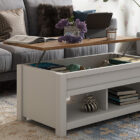A guide to get you started with parquet flooring, a blend of sophistication and durability.
Parquet flooring has a rich past. From adorning the grand halls of the Palace of Versailles during the 17th century in France to current times, it has long been admired for its quintessential charm. With its intricate patterns and curated designs, you can depend on it to add a touch of sophistication to any space.
If you are considering classic parquet flooring for your home or office, this comprehensive guide will provide you with all the information you need to make an informed decision. Read on!
What is Parquet Flooring?
Parquet flooring is a type of hardwood flooring made from small, interlocking pieces of wood. To create visually stunning designs, these pieces are arranged in geometric patterns, such as herringbone, chevron, or basketweave. Parquet flooring is renowned for its durability, versatility, and natural beauty, making it a popular choice for both residential and commercial spaces.

Types of Parquet Flooring Patterns
There are several types of parquet flooring patterns available, each with its unique characteristics:
Solid: Made from solid pieces of hardwood, solid parquet flooring offers exceptional durability and longevity. It can be sanded and refinished multiple times, allowing it to maintain its beauty for decades.
Engineered: Engineered parquet flooring is constructed from multiple layers of wood, with a top layer of hardwood veneer. This construction method makes it more stable than solid wood flooring and suitable for use in areas with fluctuating humidity levels, such as basements or kitchens.
Vinyl: Parquet vinyl flooring replicates the look of traditional parquet flooring but is made of vinyl material. It offers the aesthetic appeal of parquet with the added benefits of easy maintenance, water resistance, and affordability.
Dark Wood: This type of parquet wood flooring features hardwood pieces with a darker stain or natural wood colour. It adds a sense of sophistication and warmth to any space, making it a popular choice for elegant interiors.
Natural Wood: Natural parquet wood flooring showcases the beauty of various wood pieces, with their unique grain patterns and colours left untreated or finished with a clear sealant. It provides a rustic yet refined look that complements a wide range of interior styles.
Recycled Parquet Flooring: This is crafted from salvaged wood, often sourced from old buildings, barns, or industrial sites. This eco-friendly option adds character and charm to your space and contributes to sustainable living by repurposing materials that would otherwise go to waste.

Benefits of Parquet Flooring Patterns
- Classic charm and Appeal: This flooring adds a touch of sophistication and elegance to any room, making it a timeless flooring choice.
- Versatility: Available in various patterns, wood species, and finishes, these flooring patterns offer endless design possibilities to suit any aesthetic preference.
- Durability: Solid wood parquet flooring is incredibly durable and can withstand heavy foot traffic, making it suitable for both residential and commercial spaces.
- Easy Maintenance: With regular sweeping and occasional mopping, you can maintain this beautiful floor for years to come. Refinishing can also restore its original lustre when needed.
- Increased Property Value: Parquet flooring enhances the value of your home due to its durability, aesthetics, and timeless appeal.

Cons of Parquet Flooring Patterns
- Cost: Parquet flooring, especially solid wood parquet, can be more expensive upfront than other options. However, its longevity and timeless appeal make it a worthwhile investment in the long run.
- Susceptibility to Moisture: These floors are susceptible to moisture damage like other wood flooring types. Proper installation and maintenance are essential to prevent warping or buckling.
- Complex installation: Installing parquet flooring requires precision and expertise, especially for intricate patterns. Professional installation is recommended to ensure a flawless finish.
- Prone to scratches: While durable, this floor style can show scratches and dents over time, especially in high-traffic areas. Using furniture pads and area rugs can help minimise damage.

Maintenance of Bespoke Parquet Flooring
Installing parquet flooring requires precision and expertise to ensure a flawless finish. To achieve the best results, it is recommended that you hire a professional flooring contractor with experience in parquet installation.
Once installed, proper maintenance is essential to preserve the beauty and longevity of your parquet flooring. This includes:
- Regular sweeping or vacuuming to remove dirt and debris
- Promptly wiping up spills to prevent stains and water damage
- Using furniture pads to protect the surface from scratches and dents
- Refinishing the flooring as needed to restore its shine and lustre
- By following these maintenance tips, you can enjoy your parquet flooring for years to come.

Are Parquet Floors Expensive?
The cost of this flooring can vary depending on several factors, including the type of wood, the complexity of the pattern, and the method of installation. Generally, bespoke parquet flooring tends to be more expensive than other options, such as laminate or vinyl. Solid wood parquet, in particular, can be among the pricier options due to the quality of the wood and its longevity.
Factors such as the size of the space to be covered and any additional installation requirements can also impact the overall cost. While parquet flooring tiles may seem like a higher investment initially, many homeowners consider them a worthwhile expenditure due to their classic beauty, durability, and potential to increase property value over time.

To sum up, parquet floors are an elegant choice for any home or commercial space. With its high durability, versatility, and aesthetic appeal, it is a worthwhile investment. Whether you prefer the classic beauty of solid parquet floor panels or the modern convenience of bespoke options, there’s a parquet flooring style to suit every taste and budget. Consider incorporating this flooring into your next design project? Reach out to our parquet flooring specialists for the first step and guidance: Contact Us
Also, Check Out A Complete Guide On The Different Types Of Flooring
FAQs on Parquet Flooring
1. What types of wood are commonly used for parquet flooring, and how does the wood selection impact the overall look?
Common types of wood for parquet flooring include oak, maple, walnut, and cherry. Wood selection influences the floor’s colour, grain pattern, and durability, affecting the overall aesthetic and style of the space.
2. Can parquet flooring be sanded and refinished like solid hardwood floors?
Yes, parquet flooring can be sanded and refinished similar to solid hardwood floors, allowing for restoration of its original beauty and extending its lifespan with proper maintenance.
3. What are the pros and cons of choosing parquet flooring over other types of flooring materials?
Pros of parquet flooring include timeless elegance, durability, and versatility. Cons may include higher initial cost, susceptibility to scratches, and the need for professional installation compared to other flooring materials.
4. How does the cost of parquet flooring compare to other wood flooring options on the market?
Parquet flooring costs vary but are generally higher than laminate or vinyl flooring. However, it’s often comparable to solid hardwood floors, offering similar durability and aesthetic appeal for a premium price.
5. Are there specific acclimatization requirements for parquet flooring before installation?
Yes, parquet flooring typically requires acclimatization before installation to adjust to the environment’s humidity and temperature. This helps prevent issues such as warping or buckling post-installation, ensuring a stable and long-lasting floor.













